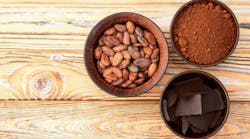Theobromine is a bitter alkaloid of the cacao plant and is found in chocolate. It is structurally similar to caffeine but differentiated from caffeine by only one methyl group. It belongs to a class of compounds known as methylxanthines and is often associated with the pleasurable and stimulant effects of chocolate consumption. Theobromine acts as a mild stimulant and vasodilator. Its chemical formula is C7H8N4O2.
Unlike caffeine, which strongly affects the central nervous system, theobromine has a gentler and longer-lasting effect. It is only slightly water-soluble and peaks more slowly in the blood, requiring two to three hours, while caffeine peaks after only 30 minutes.
Cocoa is one of the most nutrient-dense foods in the human diet. One ounce (28 grams) provides: manganese–52% recommended daily allowance (RDA), copper–50% RDA, magnesium–33% RDA, iron–24% RDA, potassium–20% RDA, phosphorus–20% RDA, zinc–12% RDA, vitamin B-12–8% RDA. It is uncommon to get such large amounts of nutrients from such a small serving size of food.
Theobromine is present in smaller amounts in tea leaves, kola nuts, and guarana, which is found in energy drinks. Theobromine has health advantages such as lowering blood pressure, raising good cholesterol, and improving focus and concentration. In addition, it may suppress amyloid levels, a hallmark in Alzheimer’s disease. Research has highlighted its potential benefits for oral health.1-5
Promise for oral health
Some research indicates that theobromine may help prevent tooth decay by inhibiting the activity of certain bacteria in the mouth, particularly Streptococcus mutans (S. mutans).1,6 It has been shown to interfere with the ability of S. mutans to produce the acids that lead to tooth enamel erosion, and it can inhibit the synthesis of extracellular polysaccharides, thereby interfering with biofilm formation of dental plaque.
The remineralization of tooth enamel shows promise with theobromine.7 This is the process where minerals such as calcium and phosphate are redeposited into the enamel, strengthening and repairing it. Research suggests that theobromine can increase the crystallinity of hydroxyapatite, the primary mineral in tooth enamel, making it more resistant to acid attacks.
Compared to fluoride, which has traditionally been used for enamel strengthening, theobromine promotes the formation of larger, more stable hydroxyapatite crystals.8 Based on other research within their study parameters, theobromine cannot be recommended as an anticaries agent.9 As always, we need to know more.
Theobromine may have anti-inflammatory properties by reducing inflammation in tissues, aiding in gingivitis and periodontal disease. There are several ways this may work. Theobromine inhibits phosphodiesterase enzymes, which break down cyclic AMP (cAMP). Higher levels of cAMP can reduce inflammation by decreasing the release of pro-inflammatory cytokines and mediators. It has antioxidant properties, which help to neutralize free radicals and reduce oxidative stress. When periodontitis occurs, increased reactive oxygen species (ROS) accumulation leads to oxidative stress and is a key factor in the inflammatory process, so reducing ROS can help mitigate inflammation. Theobromine can influence the immune system by modulating the activity of immune cells such as macrophages and T-cells. This modulation can result in a decreased production of inflammatory cytokines and other pro-inflammatory molecules.
Theobromine, as a natural compound, shows promise for enhancing oral health. Its ability to strengthen tooth enamel, inhibit bacterial growth, reduce inflammation, and act as an antioxidant makes it a valuable addition to dental care products. As ongoing research continues to reveal its potential, theobromine could become a key component, offering an alternative to traditional fluoride treatments.
A complementary approach
With the growing interest in natural and holistic health approaches, theobromine’s inclusion in dental care products aligns with consumer preferences for ingredients that come from natural sources. Its established safety profile makes theobromine an attractive ingredient for dental products such as toothpaste, gels, and mouth rinses for both adults and children. Although it may not entirely replace fluoride, theobromine provides a complementary approach that can enhance traditional dental care routines. It would be wonderful to say, “Enjoy a piece of dark chocolate for oral health,” but that comes with other potential drawbacks, such as its sugar and fat content, which can contribute to dental problems if consumed in excess, but I will always have hope!
References
- Rafiq IH, Dame-Teixeira N, Do T. The antimicrobial activity of theobromine against cariogenic microbes: an in vitro pilot study. BDJ Open. 2024;10(1):8. doi:10.1038/s41405-024-00190-y
- Mitchell ES, Slettenaar M, vd Meer N, et al. Differential contributions of theobromine and caffeine on mood, psychomotor performance and blood pressure. Physiol Behav. 2011;104(5):816-822. doi:10.1016/j.physbeh.2011.07.027
- Neufingerl N, Zebregs YE, Schuring EA, Trautwein EA. Effect of cocoa and theobromine consumption on serum HDL-cholesterol concentrations: a randomized controlled trial. Am J Clin Nutr. 2013;97(6):1201-1209. doi:10.3945/ajcn.112.047373
- Franco R, Oñatibia-Astibia A, Martínez-Pinilla E. Health benefits of methylxanthines in cacao and chocolate. Nutrients. 2013;5(10):4159-4173. doi:10.3390/nu5104159
- Cao C, Cirrito JR, Lin X, et al. Caffeine suppresses amyloid-beta levels in plasma and brain of Alzheimer’s disease transgenic mice. J Alzheimers Dis. 2009;17(3):681-697. doi:10.3233/JAD-2009-1071
- Lakshmi A, Vishnurekha C, Baghkomeh PN. Effect of theobromine in antimicrobial activity: an in vitro study. Dent Res J (Isfahan). 2019;16(2):76-80.
- Irawan MIP, Noerdin A, Eriwati YK. The effect of time in the exposure of theobromine gel to enamel and surface hardness after demineralization with 1% citric acid. J Phys Conf Ser. 2017:012005. Selected articles from the 1st Physics and Technologies in Medicine and Dentistry Symposium. doi:10.1088/1742-6596/884/1/012005
- Taneja V, Nekkanti S, Gupta K, Hassija J. Remineralization potential of theobromine on artificial carious lesions. J Int Soc Prev Community Dent. 2019;9(6):576-583. doi:10.4103/jispcd.JISPCD_265_19
- Thorn A, Lin W-S, Levon J, et al. The effect of theobromine on the in vitro de- and remineralization of enamel carious lesions. J Dent. 2020;1035:100013. doi:10.1016/j.jjodo.2020.100013








